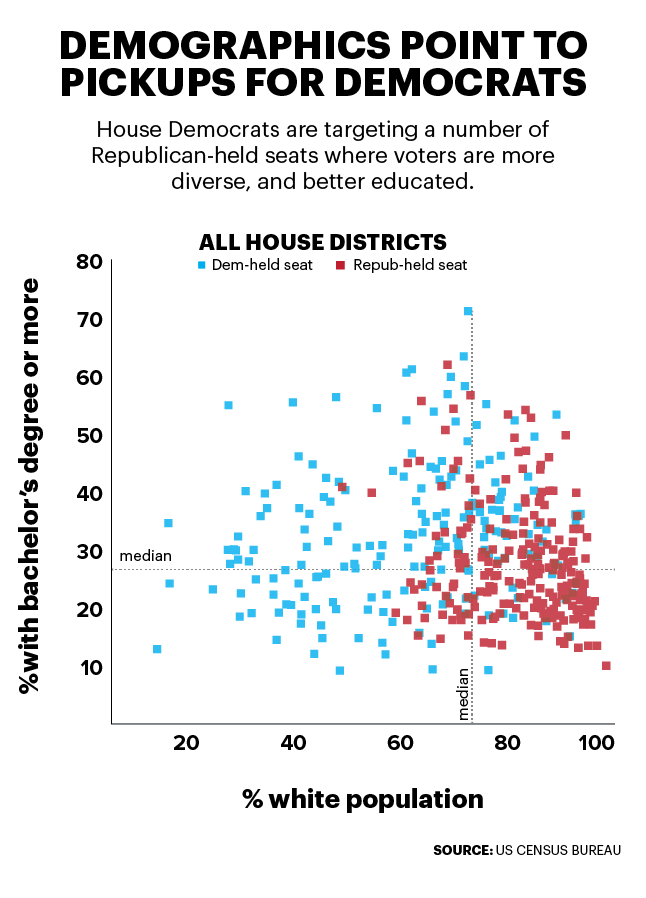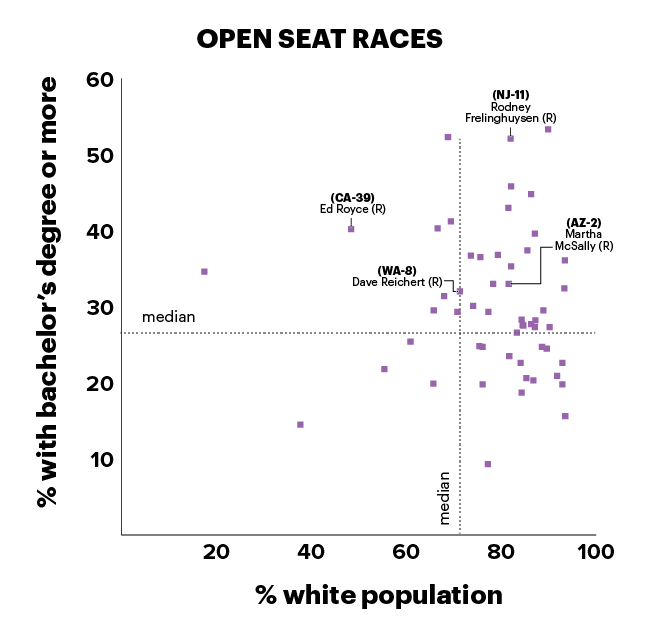Path to Dem majority lies in well-educated districts

Democrats vying to reclaim a majority in the House of Representatives for the first time in eight years are targeting districts around the country where well-educated voters hold disproportionate sway, right as those voters are expressing profound displeasure with President Trump.
An analysis of the seats both Democrats and Republicans see as key battlegrounds this year shows the path to a Democratic majority runs through two types of districts: Suburban areas near large metropolitan centers where voters are more likely to have attained college degrees, and more rural areas where the share of nonwhite voters is higher than average.
{mosads}Democrats need a net gain of 23 seats to reclaim control of the House. The party is targeting more than 100 GOP-held seats this year, but most of their best opportunities are in districts that are highly educated, highly diverse, or both.
Strategists and observers say voters with college degrees represent today’s swing vote. Many have already registered their displeasure with Trump: Of the 24 Republican-held districts with the highest levels of education, 11 voted for Democratic nominee Hillary Clinton over Trump in 2016.
Democrats also see opportunities in more diverse districts, where the percentage of white voters is far below the national average. Among the 17 most diverse Republican-held districts in the country, the Democratic Congressional Campaign Committee (DCCC) has said it will target eight seats.

Trump is struggling with both groups. Just 41 percent of white voters with a college degree approve of his job performance, while 57 percent disapprove, according to the most recent ABC News–Washington Post survey. Among nonwhites, Trump’s approval rating stands at just 17 percent.
An NBC–Wall Street Journal poll conducted this month shows 51 percent of college-educated white voters favor Democratic candidates for Congress, while 39 percent back Republicans. That’s the mirror image of the same survey’s results in 2010, when Republicans reclaimed control of the House.
“Donald Trump sets a stage that then is compounded by the Republican agenda,” said Dan Sena, who heads the DCCC. “When you’re impacting how people pay their mortgages and how they take care of their kids and their parents and themselves, those are dangerous things.”

The dismal poll numbers may be part of the reason members like Rep. Ed Royce (R-Calif.) opted to retire this year rather than to seek another term. Royce’s district, in California’s Orange County, is both highly educated and highly diverse — 40 percent of the adults in his district have a bachelor’s degree, and just 48 percent of residents are white.
Royce’s constituents “seem to be ready to jump ship and support Democrats,” said Andy Thorburn, a Democratic candidate running for the seat. “They’re looking for a more thoughtful, stable approach to a lot of the problems. The people who were Trump supporters who are talking about voting Democratic, the reasons they give [are] it’s chaotic, there’s no plan.”
Of the 38 Republican-held seats with the highest levels of college-degree attainment, the DCCC has said it will target 27. Those include seats in wealthy suburban districts like those held by Reps. Barbara Comstock (R-Va.), outside of Washington, D.C.; Mimi Walters (R-Calif.), in Orange County; and Leonard Lance (R-N.J.) and Rodney Frelinghuysen (R-N.J.), outside of New York City.

Some Republicans said the suburban battleground actually helps their party come November. To reach voters in those districts, both sides will have to spend limited resources on advertising in the most expensive media markets in the country.
“Suburban districts are extremely expensive to contest when it comes to persuading voters on television,” said Tim Saler, a Republican demographic expert. “Many of the Democrats’ top targets are in some of the priciest media markets in the entire country.”
Republicans, meanwhile, are likely to make top priorities out of districts on the other end of the scales — those where the overwhelming majority of voters are white and where fewer voters have attained a college degree.
Of the 12 districts that voted for both Trump and a Democratic member of Congress, seven are more than 80 percent white. Of the 37 seats the National Republican Congressional Committee (NRCC) has said it will target this year, a dozen are in districts where fewer than a quarter of voters have college degrees.
Many of those districts — including those held by Reps. Cheri Bustos (D-Ill.), David Loebsack (D-Iowa), Collin Peterson (D-Minn.) and Ron Kind (D-Wis.) — are in Midwestern states, where college attainment is lower than in coastal or Sun Belt regions.
“There is this regionalization that is sort of new out there, where you’ve got states like [Pennsylvania] and Ohio and Michigan and Indiana, Illinois, Wisconsin, Iowa, Minnesota, that whole belt performed more Republican than it has in a presidential [election] in a long, long time,” said John Rogers, who heads the NRCC.
Democrats will also shine a spotlight on districts where minorities play a larger role in the electorate. Districts held by members like Reps. Martha Roby (R-Ala.), Rob Woodall (R-Ga.), Robert Pittenger (R-N.C.) and Richard Hudson (R-N.C.) all have populations that are less than two-thirds white, and all appear on the DCCC’s target list.
While well-educated voters are highly likely to show up in a midterm election, that isn’t always the case for minority voters. But this year, adding to Democrats’ hopes, African-American voters especially are saying they are more likely to turn out.
Sixty-one percent of black voters said they were extremely interested in the midterms, according to the NBC–Wall Street Journal survey — 8 points higher than the percentage of white voters who said the same. The last time black voters topped white voters in enthusiasm was in 2006, when Democrats reclaimed control of the House.
Sena, the DCCC executive director, said his organization had placed 50 organizers on the ground in districts across the country. Those organizers have conducted experiments in mobilizing voters and have worked to coordinate outside groups of fired-up volunteers.
“By motivating base voters, that creates large volumes of votes,” Sena said. “The fight isn’t just about persuadable voters in the suburbs, it’s about an argument that’s applicable to all voters.”
Copyright 2023 Nexstar Media Inc. All rights reserved. This material may not be published, broadcast, rewritten, or redistributed. Regular the hill posts







